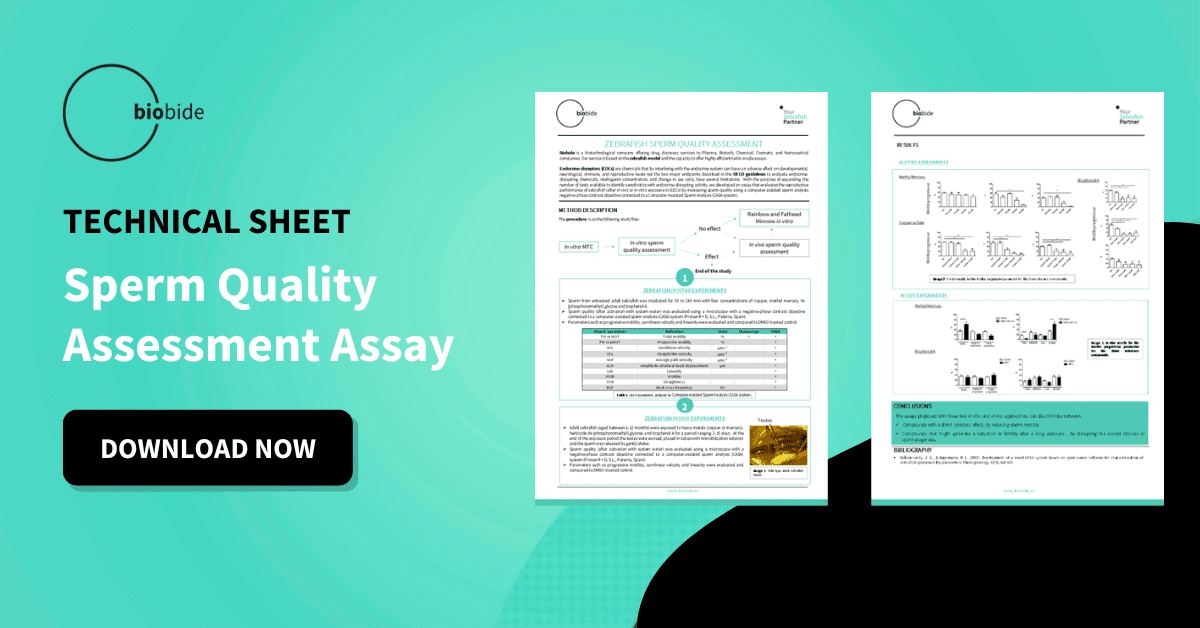Sperm cryopreservation is the method of freezing zebrafish sperm, similar to the way human sperm can be frozen for later use. This method allows a long-term and cost-effective system of preserving zebrafish for future testing. Although this is a fairly new resource, Biobide has pioneered an effective sperm cryopreservation method.
Zebrafish cryopreservation advantages
Understanding the scientific benefits of sperm cryopreservation in zebrafish has several advantages.
Whereas this fish is already easy to house and reproduce due to its small size, freezing sperm for later fertilization can further reduce maintenance costs. It means the fish do not need to be kept alive and fed until they are needed for research purposes. This can be a major advantage in laboratories with limited space and resources. Breeding and maintaining zebrafish takes time and can be difficult, especially in genetically modified fish lines that can present diseases or reproductive problems.
In this sense, it is also possible to store particular zebrafish genetic lines for future studies. This opens up the possibility of performing unique research on fish lines that present severe diseases or weak health conditions that preclude the continuous maintenance of the line. Freezing allows the genetic line to be conserved safely until it is needed and avoids damage caused to the organism by long-term maintenance of the fish line.
Furthermore, diseases sometimes occur during zebrafish husbandry. This can lead to a loss of large volumes of fish if the disease is not immediately spotted or spreads rapidly, which can be a strain on already limited research budgets.
Zebrafish cryopreservation method
Storing frozen zebrafish sperm takes up much less space than storage tanks of live fish.
This is a basic summary of the method used to freeze zebrafish sperm:
- Make a solution to freeze the sperm in
- Anesthetise the zebrafish
- Collect the sperm by gently massaging the abdomen
- Store and freeze the sperm samples in liquid nitrogen (two possible freezing methods – slow or rapid)
The sperm are then thawed when required for use and injected into the female egg for fertilization. A female zebrafish can produce up to 300 eggs every few days, which can also be frozen or used immediately. The eggs are collected by anesthetizing the female and gently squeezing out the eggs.
The zebrafish embryo develops and hatches rapidly within a few days, with its organs already formed. This makes it an ideal sample for pharmaceutical and chemical testing. The cells can be injected with a fluorescent material that fades if the sperm dies, thus allowing researchers to see its lifespan under certain conditions.

Zebrafish sperm cryopreservation for human studies
Cryopreservation of zebrafish sperm also brings light to infertility problems in men, which are common, with between 40-50% of reproductive problems being linked to male sperm. A solution is sperm cryopreservation – the freezing of semen – either for the man in question who may wish to use the sperm at a later date or for donation to someone else.
Researchers can ascertain the average numbers of offspring that can be produced from the injection of a certain number of sperm, thus being able to see how many are needed when creating human life through in vitro fertilization (IVF). They can also assess the probability of survival of the embryo after it has been injected with the sperm and if there is any damage to or effect on the frozen sperm due to freezing.
The rapid development of the use of zebrafish in medical science also allows this tropical fish to be used to study human genetics. Sperm cryopreservation in zebrafish gives an insight into genetic development and how this can affect inherited human disease.
Zebrafish sperm cryopreservation contributes also to the 3Rs policy – the Replacement, and Refinement of the use of animals in pharmaceutical and medical testing. The embryos can be used on a "supply and demand" basis, so none are wasted.
With the constant requirement for medical science to improve, zebrafish sperm cryopreservation is a successful way forward for research and development in the pharmaceutical industry. This is the way BIobide, apart from doing it internally to improve resource management, is also offering cryopreservation as a service, to help other zebrafish labs too.
Sources
- https://www.fertstert.org/article/S0015-0282(10)00670-9/fulltext
- https://www.ncbi.nlm.nih.gov/pmc/articles/PMC2737363/
- https://pubmed.ncbi.nlm.nih.gov/23624102/
- https://biobide.com/zebrafish-sperm-cryopreservation-essential-practice-cro-specialized-zebrafish-services





